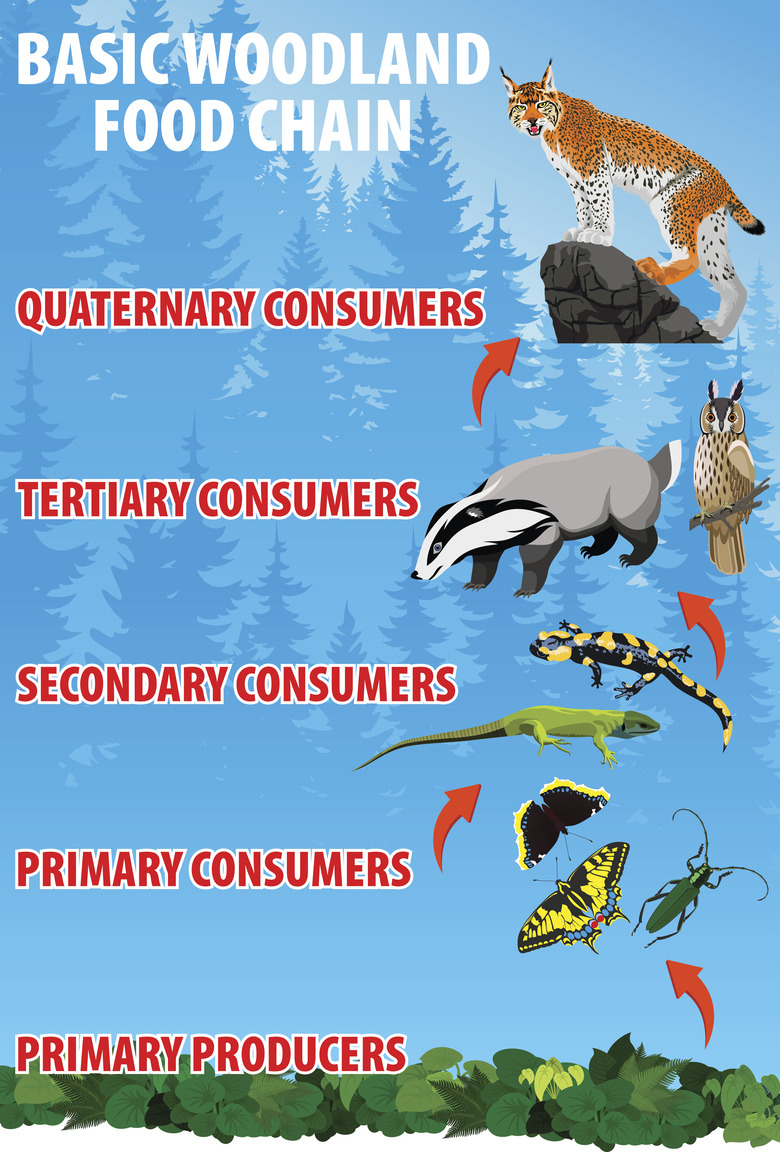What Are Three Categories Of Organisms In The Ecosystem?
An ecosystem is a complex network of interactions between biotic and abiotic components of a particular location. Living organisms such as birds, animals, plants and microorganisms form the biotic component while land, air and water form the abiotic components. Biotic and abiotic components interact with each other resulting in transfer and replenishment of energy and nutrients.
Solar energy is the main source of energy for all living organisms but not all organisms can utilize it. Only plants, algae, certain bacteria and fungi can use solar energy. This makes other organisms depend on plants directly or indirectly to gain energy and nutrients. This sequence of one organism interacting with another for food gives rise to a food chain.
There are three major categories of living things based on how they obtain energy, namely producers, consumers and decomposers. The organisms of a food chain vary according to ecosystems, for example, the organisms of a tropical ecosystem and an arctic ecosystem are different. The interactions between these organisms enable the cyclic flow of energy and nutrients in the ecosystem.
What Types of Organisms are Producers?
What Types of Organisms are Producers?
Producers form the first link of a food chain and as the name suggests, they produce food and oxygen using solar energy or chemical energy. Autotrophic plants, phytoplanktons, algae and certain species of bacteria are the producers of earth's ecosystem.
Autotrophic plants are the main producers in terrestrial ecosystems while phytoplanktons are the producers in aquatic ecosystems. Volcanic bacteria that live near volcanic vents use sulfur to produce food.
Since they are at the beginning of the food chain, producers are the direct or indirect source of food for other living organisms. For example, herbivores eat plants, carnivores eat herbivores and microorganisms and fungi feed on dead animals and plant. As one organism feeds on another, energy moves through organisms in an ecosystem in the form of carbohydrates. Producers, thus, generate the energy and nutrients that sustains the ecosystem.
What Types of Organisms are Consumers?
What Types of Organisms are Consumers?
The next level of organisms that follows the producers is the consumers. Consumers are organisms that cannot prepare their own food and depend on plants and animals for food. Depending on how they obtain food, there are four types of consumers: primary, secondary, tertiary and quaternary consumers.
Consider this food chain. In a swamp habitat, a grasshopper eats swamp grass (producer). The grasshopper gets eaten by a frog. Then the frog is eaten by a snake and the snake is eventually eaten by an eagle.
In this food chain, the grasshopper is the primary consumer, the frog is the secondary consumer, the snake is the tertiary consumer and the eagle is the quaternary consumer.In any food chain, apex predators, such as eagle, are the highest level consumers, as they do not have a natural predator. Lions, eagles, sharks and human beings are apex predators.
Which Organisms are Decomposers?
Which Organisms are Decomposers?
The earth contains a limited amount of organic matter that is necessary for the survival of living organisms. Therefore, all organic matter needs to be continuously replenished in nature. This process is carried out by decomposers, the final link in the food chain.
Decomposers are microorganisms that break down complex organic matter into simple inorganic matter through chemical reactions. Decomposers such as bacteria and fungi scavenge dead and decaying plant and animal bodies and keep nutrients and energy circulating in nature.
All living organisms are made up of complex organic matter such as complex carbohydrates, proteins and fats. When they die, decomposers act on their dead bodies and return their organic matter back to nature in inorganic form. The inorganic matter enters the soil as nutrients that are absorbed by plants.
Cite This Article
MLA
Naik, Kavita. "What Are Three Categories Of Organisms In The Ecosystem?" sciencing.com, https://www.sciencing.com/three-categories-organisms-ecosystem-8275213/. 17 June 2019.
APA
Naik, Kavita. (2019, June 17). What Are Three Categories Of Organisms In The Ecosystem?. sciencing.com. Retrieved from https://www.sciencing.com/three-categories-organisms-ecosystem-8275213/
Chicago
Naik, Kavita. What Are Three Categories Of Organisms In The Ecosystem? last modified August 30, 2022. https://www.sciencing.com/three-categories-organisms-ecosystem-8275213/
